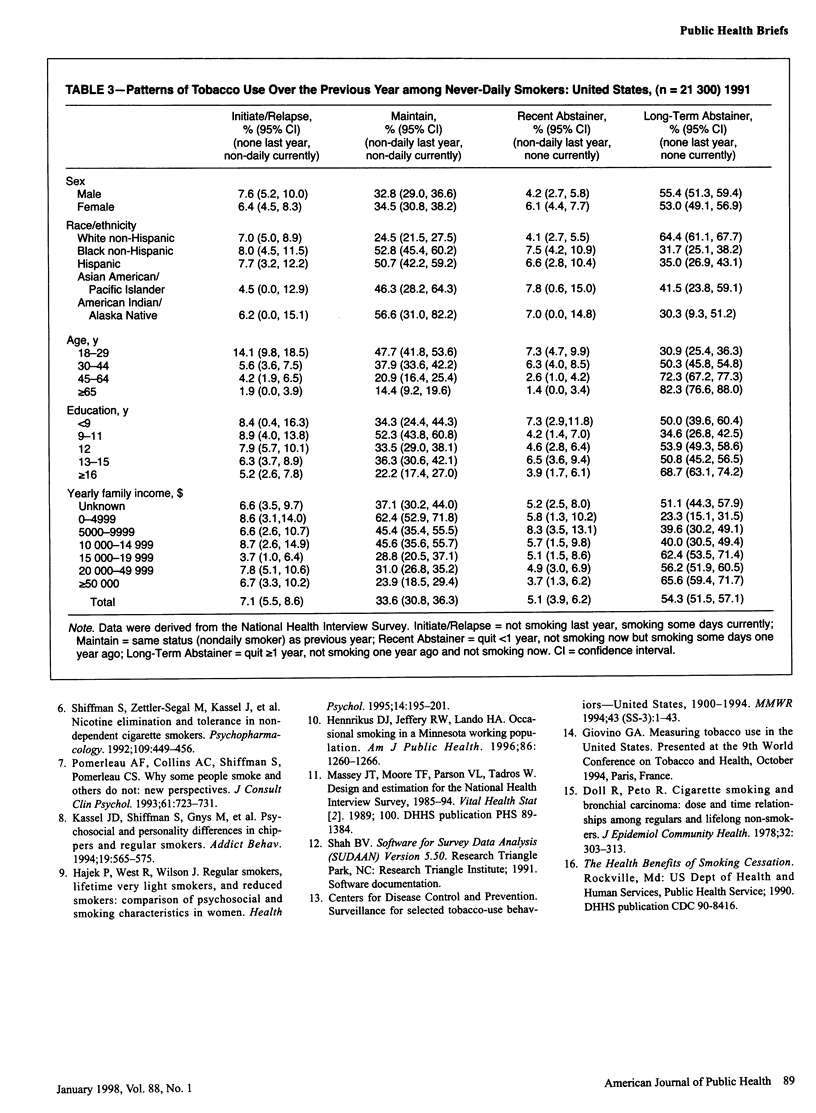Abstract
OBJECTIVES: This study assessed the prevalence of and demographic variables associated with lifetime never-daily smoking in the United States. METHODS: Descriptive demographic data and logistic regression analyses were used to examine associations with never-daily smoking. RESULTS: Lifetime never-daily smokers constituted a significant minority of non-White smokers. There was a strong association between never-daily smoking and college education among young adults, particularly men. Although never-daily smoking was associated with initiation behavior among young smokers, it also represented a persistent pattern for some smokers, particularly non-Whites and Hispanics. CONCLUSIONS: The demographic distribution of never-daily smoking may have implications for developing culturally appropriate smoking prevention and cessation strategies.
Full text
PDF



Selected References
These references are in PubMed. This may not be the complete list of references from this article.
- Doll R., Peto R. Cigarette smoking and bronchial carcinoma: dose and time relationships among regular smokers and lifelong non-smokers. J Epidemiol Community Health. 1978 Dec;32(4):303–313. doi: 10.1136/jech.32.4.303. [DOI] [PMC free article] [PubMed] [Google Scholar]
- Hajek P., West R., Wilson J. Regular smokers, lifetime very light smokers, and reduced smokers: comparison of psychosocial and smoking characteristics in women. Health Psychol. 1995 May;14(3):195–201. doi: 10.1037//0278-6133.14.3.195. [DOI] [PubMed] [Google Scholar]
- Hennrikus D. J., Jeffery R. W., Lando H. A. Occasional smoking in a Minnesota working population. Am J Public Health. 1996 Sep;86(9):1260–1266. doi: 10.2105/ajph.86.9.1260. [DOI] [PMC free article] [PubMed] [Google Scholar]
- Kassel J. D., Shiffman S., Gnys M., Paty J., Zettler-Segal M. Psychosocial and personality differences in chippers and regular smokers. Addict Behav. 1994 Sep-Oct;19(5):565–575. doi: 10.1016/0306-4603(94)90012-4. [DOI] [PubMed] [Google Scholar]
- Owen N., Kent P., Wakefield M., Roberts L. Low-rate smokers. Prev Med. 1995 Jan;24(1):80–84. doi: 10.1006/pmed.1995.1011. [DOI] [PubMed] [Google Scholar]
- Pomerleau O. F., Collins A. C., Shiffman S., Pomerleau C. S. Why some people smoke and others do not: new perspectives. J Consult Clin Psychol. 1993 Oct;61(5):723–731. doi: 10.1037//0022-006x.61.5.723. [DOI] [PubMed] [Google Scholar]
- Shiffman S. Tobacco "chippers"--individual differences in tobacco dependence. Psychopharmacology (Berl) 1989;97(4):539–547. doi: 10.1007/BF00439561. [DOI] [PubMed] [Google Scholar]
- Shiffman S., Zettler-Segal M., Kassel J., Paty J., Benowitz N. L., O'Brien G. Nicotine elimination and tolerance in non-dependent cigarette smokers. Psychopharmacology (Berl) 1992;109(4):449–456. doi: 10.1007/BF02247722. [DOI] [PubMed] [Google Scholar]


